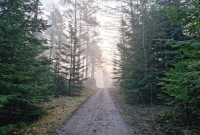Support strong Canadian climate journalism for 2025
Clouds hang low over Crowsnest Mountain, an imposing landmark northwest of Blairmore, Alta. A dark grey ceiling obscures half of its pyramid-shaped peak, while the lower part of the mountain is barely visible through the lashing rain. To the east, the carved-out slopes of the defunct Grassy Mountain coal mine look black against the vibrant green forest that surrounds the site.
Water cascades down the exposed rock of the mine. Half the mountain is gone, as if slashed by the hand of a powerful force, bringing to mind the haunting lyrics of late rock guitarist Jimi Hendrix’s Voodoo Child (Slight Return): “Well, I stand up next to a mountain. And chop it down with the edge of my hand.”
Water tumbles into the tailings pool below and rushes down the access roads, eventually finding its way to Gold Creek and Blairmore Creek. These streams send a torrent rushing down to the Crowsnest River, which, in turn, feeds the Oldman River, a critical watershed for southern Alberta’s agricultural region.
In this way, selenium and other unwanted minerals from the abandoned mine find their way into groundwater and irrigation systems, threatening to contaminate the livestock and crops that contribute to Alberta’s $9-billion agricultural sector.
Beyond Grassy Mountain, a vast wilderness is pierced by exploration roads that wind through the terrain like the roots of a noxious weed. These cause fragmentation in what would otherwise have been an undisturbed ecosystem. The dirt roads produce dust, mud and runoff where trees and healthy soil once stored water and supported the region’s hydrological cycle.
Once these roads are built, they are rarely reclaimed for nature. Instead, they become a popular means of wilderness access for off-highway vehicle (OHV) users, who create more trails deeper into the already fragile ecosystems.
The Alberta’s Trails Act (Bill 79) claims to protect and preserve the province’s outdoors, but organizations like the Environmental Law Centre have expressed concerns that “the act is significantly, if not fatally, flawed when it comes to ensuring recreation on Alberta’s public lands is conducted in a way that minimizes impacts on species, water, and other users.”
Between 2018 and 2021, access roads spread throughout the Eastern Slopes of the Canadian Rockies when the Alberta Energy Regulator issued coal exploration permits allowing “235 kilometres of new coal exploration roads and 724 test drill pits in southwest Alberta,” according to a Canadian Parks and Wilderness Society report.
When a proposal to reopen the Grassy Mountain coal mine was rejected, a naïve environmentalist might assume the road-making equipment would finally be silenced in the wilds of the Eastern Slopes. However, just as the Grassy Mountain project was being stopped in its tracks, Alberta’s United Conservative Party government signed a 20-year forestry management agreement (FMA) with Crowsnest Forest Products in the summer of 2021 that permits the corporation to harvest timber and build roads in the C5 Forest Management Area, which is a 3,511-square-kilometre parcel of land that surrounds the Grassy Mountain site.
The Alberta Wilderness Association expressed concerns over the FMA increasing the annual allowable cut and the focus on timber and economic value versus ecosystem health. The FMA also includes provisions for compensation in the event future governments reduce the harvest levels in the C5 area.
The forestry deal was another pillar in the government’s plans to monetize the Eastern Slopes region. Coal mining may be on hold, but clear-cut logging will increase in a region where the downstream agriculture industry can ill afford to suffer the resulting damage to the watershed.
Forests catch rainfall and slow the water’s progress to the ground. The root system and rich soil in the forest act like a sponge that stores water and reduces runoff, allowing water to slowly feed underground aquifers. Clear-cutting removes all tree cover, exposes the soil, and increases erosion from wind and rain.
According to Global Forest Watch, forests buffer against the impacts of droughts and floods. Their ecosystem services are critical to the health of watersheds, which are vital to the nearby agricultural regions that thirst for water.
Global warming will create milder winters that result in a reduced snowpack when precipitation falls as rain instead of snow. Warming will also cause hotter summers that result in droughts and greater stress on forests. Clear-cuts and logging roads only exacerbate the problem.
In the midst of a rainy spring day in the Crowsnest Pass, it’s hard to see a future where forests are vanishing at an alarming rate due to the impacts of drought, bark beetle infestation, wildfires, logging, mining and road building. We turn a blind eye to the reckless disregard for nature that threatens wildlife and a diverse network of living organisms.
The Crowsnest River begins in Blairmore and winds east towards the Oldman River Dam. As the rain flows in from the many creeks en route, the water churns wildly and turns an earthy colour. An extreme rain event will cause the river to overflow its banks and force dam operators to open the floodgates.
The Oldman flows east across southern Alberta and joins the South Saskatchewan River before snaking its way out of the province. At high flow, the rivers provide an express route for the water to leave the region. Come summer, it will be missed by everything that lives there.
Rob Miller is a retired systems engineer, formerly with General Dynamics Canada, who now volunteers with the Calgary Climate Hub and writes on behalf of Eco-Elders for Climate Action.






Comments